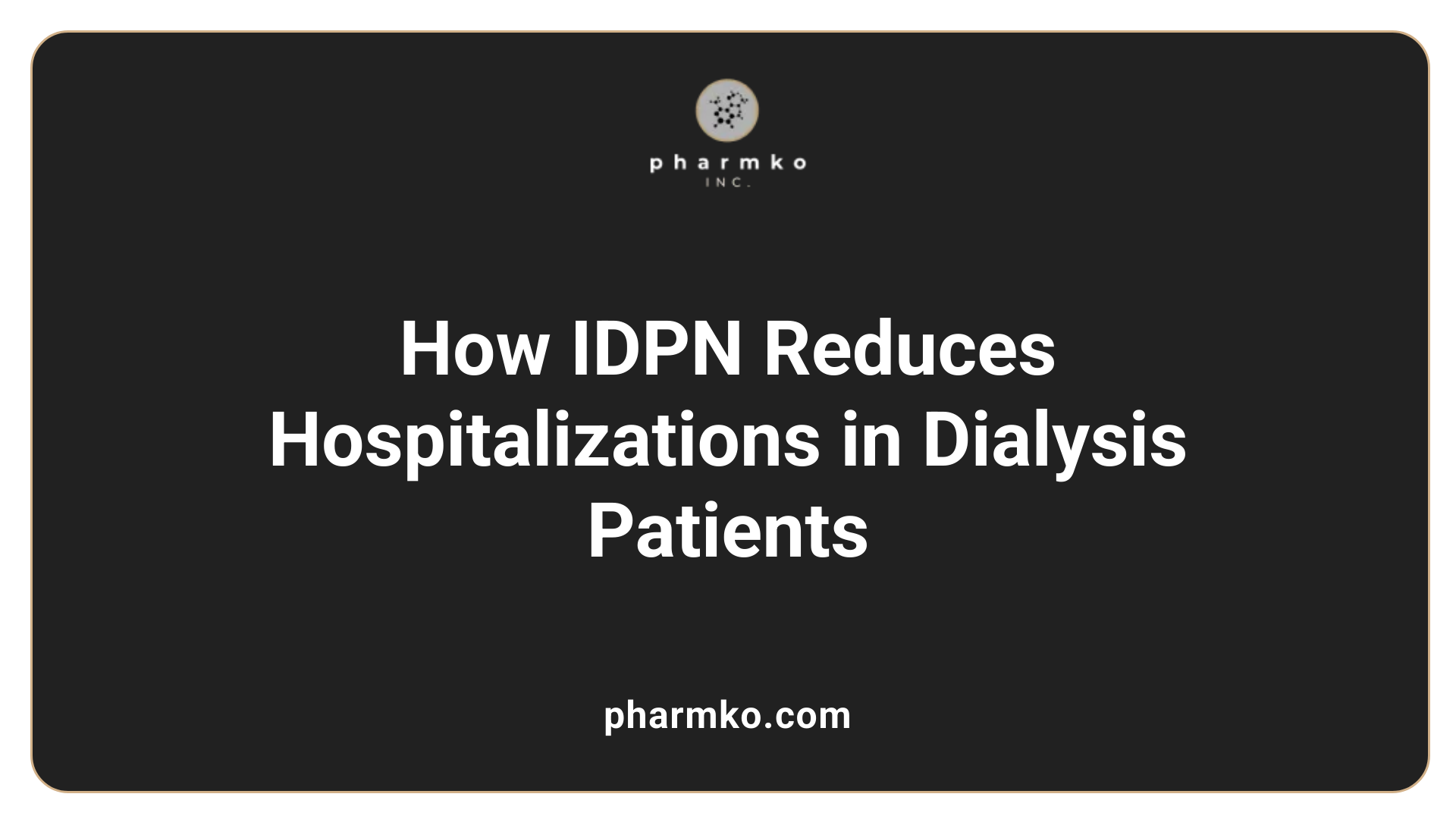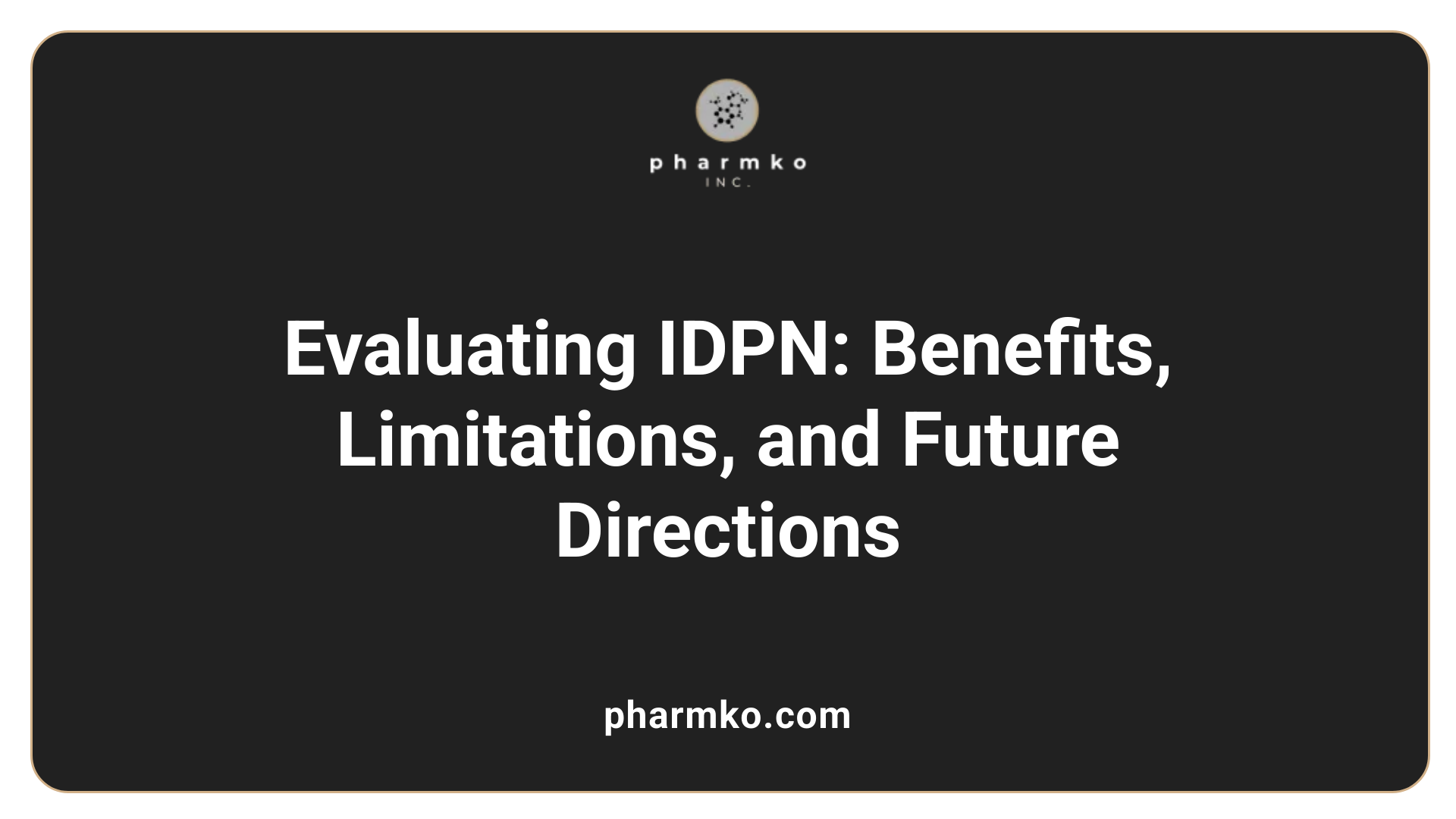The Role of IDPN in Reducing Hospitalizations for Dialysis Patients
Understanding the Potential of IDPN in Dialysis Care
Malnutrition is a pervasive issue among hemodialysis patients, contributing to increased hospitalizations, mortality, and reduced quality of life. Intradialytic Parenteral Nutrition (IDPN) has emerged as an intervention designed to address nutritional deficiencies during dialysis sessions. This article explores the role of IDPN in reducing hospitalizations, examines current clinical evidence and guidelines, and discusses its benefits, risks, and mechanisms in improving patient health.
What is Intradialytic Parenteral Nutrition (IDPN)?

Definition and purpose of IDPN
Intradialytic Parenteral Nutrition (IDPN) is a specialized form of intravenous nutrition provided during hemodialysis sessions. It is designed to help patients who are malnourished or at risk of malnutrition, which is common among those undergoing long-term dialysis. The goal of IDPN is to deliver essential nutrients directly into the bloodstream to support healing, muscle preservation, and overall health.
Components of IDPN solution
The nutritional mixture used in IDPN typically includes a blend of dextrose (carbohydrates), amino acids (protein building blocks), lipids (fats), electrolytes, vitamins, and trace elements. This combination supplies calories and nutrients needed for recovery and maintenance. The solution’s composition is customized based on each patient’s nutritional needs and tolerance.
Administration during dialysis sessions
IDPN is administered via infusion pumps that deliver the nutrient solution into the patient during their hemodialysis session, usually lasting around 3 to 4 hours. This method leverages the existing dialysis routine, making it convenient and reducing the need for additional appointments. It provides up to 25% of the patient's nutritional requirement during treatment and can be continued for several months with gradual adjustments.
Target patient population
The primary candidates for IDPN are patients with significant protein-energy wasting, often characterized by low serum albumin and prealbumin levels. While it is especially recommended for those who cannot tolerate oral nutrition or when oral supplementation fails, current guidelines suggest reserving IDPN for cases where other nutritional interventions have not succeeded. This approach aims to ensure safety and cost-effectiveness.
Overall, IDPN aims to improve markers of nutritional status like serum prealbumin and albumin, help reduce hospitalizations related to malnutrition, and potentially enhance survival rates in dialysis patients.
Clinical guidelines and practice considerations for IDPN use

What are the guidelines and clinical practices associated with IDPN use in dialysis patients?
Current guidelines, including those from the European Society for Clinical Nutrition and Metabolism (ESPEN), recommend that intradialytic parenteral nutrition (IDPN) should be considered mainly for patients with significant malnutrition who are unable to tolerate or respond to oral or enteral nutritional interventions. These guidelines are based on limited but growing evidence, emphasizing a cautious and individualized approach.
In clinical practice, IDPN is administered during dialysis sessions, providing essential nutrients such as amino acids, lipids, dextrose, and sometimes additional oral supplements. The formulations are tailored to meet each patient's specific nutritional deficits. Healthcare practitioners routinely evaluate the patient’s nutritional status through physical assessments and biochemical tests, including serum albumin, pre-albumin, and body composition measures.
Monitoring involves regular assessment of serum nutritional markers, body weight, and patient tolerance. While some studies have shown improvements in serum prealbumin and albumin levels, these biochemical changes are used as surrogate markers rather than definitive indicators of improved clinical outcomes.
Despite mixed evidence regarding long-term benefits like reduced mortality or hospitalizations, many clinicians consider IDPN as a supportive measure in malnourished hemodialysis patients. Ongoing evaluation is crucial, with the therapy adapted or discontinued based on patient response, tolerance, and evolving nutritional needs.
In sum, IDPN is to be used selectively, following a comprehensive nutritional assessment, aligning with guideline recommendations to avoid premature or unnecessary use. The importance of individualized treatment plans and vigilant monitoring cannot be overstated.
Evidence of IDPN's impact on nutritional markers and hospitalizations

What are the benefits and risks of IDPN therapy for dialysis patients?
Intradialytic Parenteral Nutrition (IDPN) has been explored as an intervention to improve the nutritional status of patients undergoing hemodialysis, particularly those suffering from malnutrition or protein-energy wasting (PEW). Clinical studies, including a multicenter randomized controlled trial with 107 hemodialysis patients, demonstrate that IDPN can lead to significant improvements in important nutritional markers. For example, after 16 weeks of treatment, serum prealbumin levels increased markedly in patients receiving IDPN (+26.31 mg/L), while levels decreased in control groups. Prealbumin and albumin are conserved markers for nutritional status and are associated with survival prospects.
Furthermore, IDPN contributes to increases in serum albumin levels, which persisted for at least six months. These improvements are complemented by gains in body weight, muscle mass, and spontaneous food intake, alongside reductions in the malnutrition inflammation score (MIS). Such enhancements suggest that IDPN can support healing and reduce the risk of complications associated with malnutrition.
The therapy also appears to reduce hospitalizations. One study observes a 30% decrease in hospital admission rates and a 40% shortening of hospital stays among those responding well to IDPN. Responders often maintained improvements enough to discontinue IDPN by increasing oral intake, leading to lower mortality rates relative to nonresponders.
However, the evidence also points to several considerations for clinical application. Risks associated with IDPN are limited but include potential issues like hyperglycemia, volume overload, or liver function disturbances. While adverse effects seem comparable to control treatments, data are limited due to the heterogeneity of studies and small sample sizes.
Cost is another factor, as IDPN is generally more expensive than dietary counseling or oral supplements, yet some reports suggest it may ultimately reduce hospitalization costs and length of stays.
Current guidelines recommend that IDPN be reserved for patients who do not respond to or cannot tolerate traditional nutritional interventions, emphasizing individualized treatment. Proper patient selection, close monitoring of blood glucose, infusion symptoms, and liver function tests are vital to maximizing benefits and minimizing risks.
In summary, IDPN provides measurable improvements in nutritional markers and potentially lowers hospitalization and mortality risks in malnourished dialysis patients. Nonetheless, it should be used judiciously within a comprehensive care plan, considering individual patient needs and resource constraints.
Mechanisms through which IDPN may influence hospitalization rates

How does IDPN influence hospitalization rates among dialysis patients?
IDPN appears to play a role in lowering hospitalization rates for patients undergoing hemodialysis, especially those who respond favorably to the therapy. When patients experience improved nutritional status—indicated by increases in serum markers like albumin and total protein—they tend to have a better overall health profile.
Studies have reported that during IDPN treatment, hospitalization rates drop significantly, with some showing reductions of up to 30%. This decline is likely linked to enhanced immune function and a decreased risk of infections, common reasons for hospitalization in dialysis populations.
Furthermore, IDPN's ability to improve nutritional parameters can lead to less frequent and shorter hospital stays—reducing their duration by about 40%.
The combined effects of better nutritional status, improved immune defenses, and enhanced tolerance to dialysis procedures contribute to fewer complications. These range from infections to cardiovascular issues, all of which can result in hospital admissions.
Overall, IDPN's influence on nutritional markers and immune health offers a promising approach to reducing hospitalizations and improving outcomes for malnourished dialysis patients.
Conclusion: Evaluating the role of IDPN in dialysis patient care
 Recent research indicates that Intradialytic Parenteral Nutrition (IDPN) can improve nutritional markers in hemodialysis patients, including serum albumin and prealbumin levels. These biochemical improvements are often accompanied by gains in body weight, better appetite, and overall nutritional status. Improved nutrition is important because it has been linked to better survival outcomes and fewer hospitalizations.
Recent research indicates that Intradialytic Parenteral Nutrition (IDPN) can improve nutritional markers in hemodialysis patients, including serum albumin and prealbumin levels. These biochemical improvements are often accompanied by gains in body weight, better appetite, and overall nutritional status. Improved nutrition is important because it has been linked to better survival outcomes and fewer hospitalizations.
A significant study—a multicenter, randomized controlled trial involving 107 patients—showed that patients treated with IDPN experienced a notable increase in serum prealbumin after 16 weeks. This suggests that IDPN may positively influence nutritional health in dialysis patients. Moreover, patients responding to the therapy had a lower mortality rate and, in some cases, could transition away from relying on IDPN by increasing oral intake.
Regarding hospital-related outcomes, evidence points to a potential reduction in hospitalizations. Some findings suggest that patients receiving IDPN experienced a 30% decrease in hospitalization rates and a 40% reduction in the length of hospital stays. Additionally, improved serum albumin levels through IDPN might help lower the risk of infection-related hospitalizations, which are common in malnourished dialysis patients.
However, current research also highlights limitations. Many studies show no consistent improvements in clinical outcomes like mortality, quality of life, or hospitalization rates compared to other nutritional interventions. Large-scale, high-quality trials yield mixed results, and only limited data are available on adverse effects or cost-effectiveness.
Future research should focus on larger, longer-term studies to better understand which patient groups benefit most from IDPN. Further investigations are needed to clarify its role in reducing hospital admissions and improving overall outcomes, especially considering the higher costs associated with the therapy. Also, exploring personalized approaches and identifying subgroups who respond best could help optimize treatment strategies.
In summary, while IDPN can enhance nutritional markers and may reduce hospitalizations in certain patients, its routine use remains controversial without more definitive evidence. Adhering to current guidelines, which recommend restraint until other nutritional methods fail, remains prudent until further evidence clarifies its overall clinical benefit.
Final Thoughts: Optimizing Nutritional Support in Dialysis
While IDPN demonstrates promise in improving nutritional parameters and potentially reducing hospitalizations, its application must be carefully considered within the context of individual patient needs and existing guidelines. The current body of evidence indicates that nutritional interventions, especially when appropriately timed and monitored, can support better health outcomes for dialysis patients. Future research should focus on long-term effects, cost-effectiveness, and identifying patient subgroups most likely to benefit from IDPN, ultimately guiding personalized care strategies to reduce hospitalizations and improve quality of life in this vulnerable population.
References
- Evidence Brief: Use of Intradialytic Parenteral Nutrition (IDPN ... - NCBI
- Intradialytic parenteral nutrition in maintenance hemodialysis ...
- The beneficial effects of intradialytic parenteral nutrition in ... - Nature
- A Lifeline for Dialysis Patients - Patient Care America
- The Effect of Intradialytic Parenteral Nutrition on Hospitalization Rate ...
- Nephrology - Clinical Nutrition EMEA - Baxter
- Evidence Brief: Treatment for Malnutrition in Hemodialysis Patients
- [PDF] How IDPN & IPN therapy can benefit your patients.
- [PDF] Use of Intradialytic Parenteral Nutrition in Hemodialysis Patients
- Intradialytic parenteral nutrition for patients on hemodialysis













